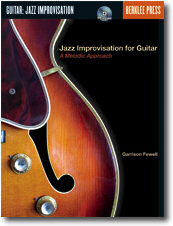|
If you are looking for ways to add new colors to your solos and avoid repeating the same diatonic patterns when playing over chord changes, melodic triad substitutions offer a simple but effective solution.
Here's how it works: start with a II-7 / V7/ I progression in the key of C major
(D-7 / G7 / Cmaj7) but instead of playing the mixolydian scale over the G7 chord, try adding altered tensions b9, #9, b5 and #5 to the notes of a G7 arpeggio. This combination gives you a G altered dominant scale.

It's easier to think of the G altered dominant scale as an Ab melodic minor scale starting on the 7th degree, G. The notes are exactly the same with only one enharmonic difference – the B natural is spelled as Cb.

The next step is to build diatonic triads from Ab melodic minor, starting on each one of the altered tensions of the G7 chord. You'll get Ab minor, Bb minor, Db major and Eb major triads. These triad substitutions each contain two altered notes of G7

Now try building a melodic phrase over the II-7 / V7 / I progression using an Ab min triad over the G7 chord. You can add smooth chromatic motion to your lines if you also play substitute triads over the D-7 and Cmaj7 chords: An A minor triad contains the 5th, b7th and 9th degrees of D-7 and a G major triad includes the 5, 7 and 9th degrees of Cmaj7. (Note: fingerings are written above the staff and fretboard positions are marked with Roman numerals beneath the staff)

Here is another melodic example using the same approach:

The next example uses both Ab minor and Bb minor triads over G7.

Two more melodic substitutions derived from Ab melodic minor will help you expand the colors of your solo lines over G7. This example uses Db and Eb major triads to create the G altered dominant sound.

|

Garrison's new book
Jazz Improvisation
for Guitar – a Melodic Approach
is now available on Berklee Press
and distributed internationally by Hal Leonard
It includes
tablature for guitar and comes complete with a 90+ track cd with back-up
trio tracks for play along exercises by Garrison, bassist Steve LaSpina
(a long time collaborator with guitarist
Jim Hall)
and drummer John Riley.
More articles by Garrison are available online through his website:
www.garrisonfewell.com/pages/LESS.html
You can download Garrison's lessons for Guitar Player magazine directly
from Truefire Music
http://truefire.com/list.html?store=audio_lessons&viewauthor=208
These lessons include tab for guitar and
audio tracks of all the musical examples.
|
Insert a comment
©
2001, 2005 Jazzitalia.net - Garrison Fewell - All rights reserved
|
© 2000 - 2025 All the material published on Jazzitalia is exclusively owned by the author. Moreover it is protected by International Copyright, so it is forbidden any use of it which isn't authorised by the rights' owner.
|
This page has 10.744 hits
Publishing Date: 27/08/2005

|
| 
